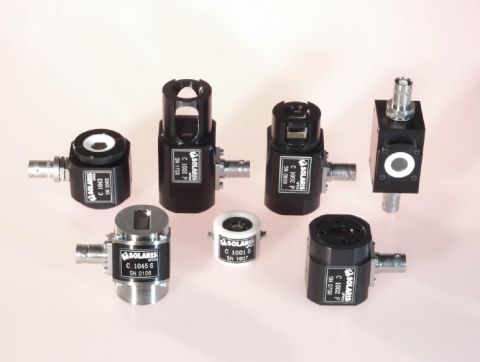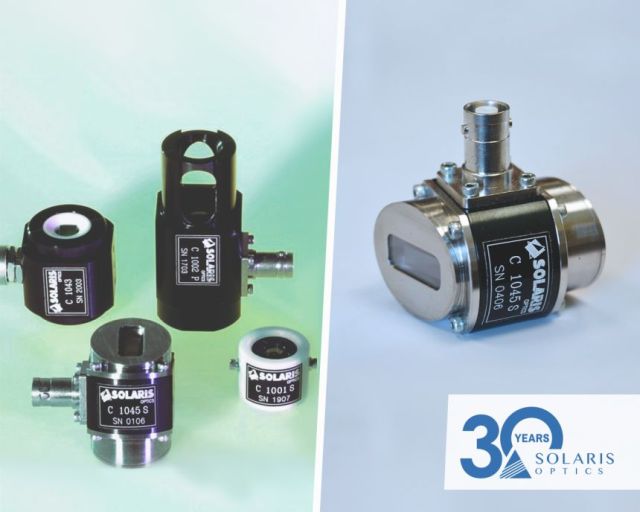Optical Modulators for Laser Q-switching
Published: April 28, 2021
Optical modulators are key building blocks for many optical systems and functions, including data transmission, laser printing, Q-switching, active-mode locking, shifting beam spectral frequency and much more. In this article we will discuss the two major modulator types for laser Q-switching: electro-optic or acousto-optic modulators. While both allow for producing high-power, ultra-short laser pulses, system designers should know the strong and weak points of each technology to choose the best option for their application.
The basics of Q-switching
Q-switching is a common technique to produce ultra-short laser pulses. It involves increasing resonator loss with the use of a modulator, which leads to increase of accumulated electron population difference in the lasing medium as the pump is continuously delivering power. When the modulator is set to ‘open’ mode, the resonator quality factor Q rapidly increases which results in a high-intense, ultra-short laser pulse. Not every laser can be Q-switched and the technique is mostly used with Nd:YAG and other solid state lasers, while gas lasers usually depend on other solutions.

Fig. 1. Optical modulators – Pockels cells
While it is possible to build Q-switches based on mechanical or dye modulators, the acousto-optic and electro-optic options provide the best performance in terms of possible on/off frequencies and resulting output power. The ease of transforming signal from electrical to optical form is another factor which contributes to popularity of these devices.
Acousto-optic modulators
Acousto-optic modulators take advantage of the phenomena in which an acoustic wave propagating in an optical medium produces a periodic modulation of the optical medium refractive index. The resulting phase grating leads to diffraction of incident light and the effect is used for spatial, temporal, and spectral light modulation. The structure of acousto-optic modulator consists of a block of optical material, such as Quartz, fused silica, flint glass or tellurium dioxide, with an attached piezoelectric transducer to its side. A radio-frequency driver generates acoustic signal which scatters passing beam in a predictable manner. The amount of light scattered is dependent on the amplitude of the piezo-induced sound wave within the optical material.
The ongoing technological advancements in terms of materials and broadband transducers have made acousto-optic modulators a reliable technology for laser beam control. The traditional application is in high-power Nd:YAG systems in industrial and military applications.
While acousto-optic modulators offer low insertion loss, they generally provide lower gain compared to electro-optic modulators. The frequency of operation ranges from 27 MHz to 1 GHz, which means they are less fit for high bandwidth applications. However, acousto-optic devices usually have an advantage of not requiring high driving voltage and are well suited for broader wavelength spectrum in IR, VIS & UV range.
Electro-optic Modulators
Electro-optic modulators (EOM) are more flexible option in terms of light parameters they can modulate – they allow to control the amplitude, polarization or position of an optical beam. Electro-optic modulators provide a backbone to modern communication technologies, analog and digital processing, optical sensing and many more. What makes electro-optical modulators stand out from its acousto-optic or mechanical counterparts is much higher frequencies, in GHz range. This makes it a preferable solution for high-speed optical communication as it allows for data-transfer rates that are not matched by other modulation techniques. EOM-based Q-switching solutions offer high speed and high gain, although usually higher voltage is required compared to acousto-optic modulators. Hence the most common use is in the visible spectrum (as the half-voltage increases with wavelength). However Pockels cells for infrared (up to far IR) are also available on the market.
The electro-optic phenomena describes the change in materials’ anisotropic optical properties under the external electric field. There are several technologies that make use of an electro-optic effect to modulate the light wave. The common principle is the ability to modulate optical properties of a material, e.g. index of refraction or natural birefringence, in a controlled manner by applying an external voltage.
Pockels Cells Optical Modulators
The linear electro-optic effect, known as Pockels effect, can be observed in crystals lacking a center of symmetry where birefringence is produced in a material proportionally to the applied electric field. The most common materials for Pockels cells are electro-optic crystals such as di-deuterium phosphate (KDDP), barium borate (BBO), lithium niobate (LiNbO3), lithium tantalate (LiTaO3), and ammonium dihydrogen phosphate (NH4H2PO4, ADP). Another alternative for a Pockels cell crystal is rubidium titanyl phosphate (RbTiOPO, RTP), giving an RTP Pockels cell, oftentimes used in neodynium lasers, such as Nd:YAG.
Pockels cells in combination with polarizers can be used as amplitude and phase modulators with the advantages of low drive voltages, low insertion loss and ability to handle high optical powers. The device is capable of reaching modulation frequencies of gigahertz range and can serve as shutter with response time of less than 1 nanosecond.
A sole Pockels cell itself can serve as a phase modulator, as it has a capability to change phase of the passing light when it travels in a direction of one of its optical axes without affecting its polarization. A common setup for light intensity modulation is a Pockels cell placed between two polarizers perpendicular to each other. At zero voltage the crystal does not change light polarization, causing the beam to be fully blocked by the second polarizer. Applying voltage induces a birefringence in the crystal, which in turn changes light polarization from linear to elliptical and the light can pass through the second polarizer. The amount of light passing depends on applied voltage, and specifically at the half-wave voltage the modulator in in open shutter mode transferring all the light.
Kerr Cells Optical Modulators
A similar phenomena is called quadratic electro-optic effect, also known as Kerr effect. Kerr effectcan be observed in practically all materials and describes a change in magnitude of the birefringence which is proportional to the square of the electric field.
This flexibility in a choice of material allows designers to align device to the specific needs of the target application, especially when there is a need to handle high optical powers. The Kerr modulators can operate with frequencies in a range of tens of gigahertz with driving voltages of up to tens of kilovolts. A Kerr cell placed between two crossed polarizers is a simple light intensity modulator, or shutter, that allows for light to pass through depending on the applied voltage.
Optical Modulators – Summary
In the article we summarized main optical modulators used for Q-switching, i.e. acousto-optic modulators and electro-optic modulators (Pockels cells, Kerr cells) as well as related design considerations for selecting either of the technologies. Naturally a selection is always a matter of a specific application and technical boundaries.
Solaris Optics manufactures Pockels cells (di-deuterium phosphate KDDP and lithium niobate LiNbO3) in our facilities in Poland. Should you have questions regarding optic modulators, please do not hesitate to contact us!
***

